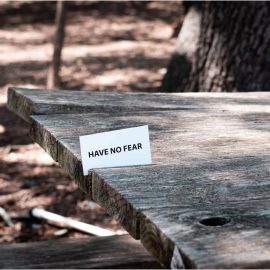

This article is an excerpt from the Shortform book guide to "Radical Acceptance" by Tara Brach. Shortform has the world's best summaries and analyses of books you should be reading.
Like this article? Sign up for a free trial here .
Why is it important to be fully aware of your body? How can you escape the waterfall of thoughts and be present in the moment?
In today’s society, we are tormented by a constant stream of thoughts. We can’t even hug a friend without worrying about how long we should hold it or what to say after we let go. Buddha called this the waterfall and it is important to escape it.
Continue reading for advice on how to escape your thoughts and improve your bodily awareness.
Mindfulness of the Body
The body is a good place to begin friendly questioning. We experience life through our bodies, yet are often so wrapped up in our thoughts that we miss out on a lot of it. Some people have described the lack of bodily awareness as only being alive from the neck up; so busy with thoughts and worries that they aren’t fully aware of their bodies.
Even when we’re aware of a strong physical sensation, like a cool breeze or the sound of rain, we’re almost never fully present in the moment; we have an inner monologue running over it. When we hug a friend, are we fully appreciating the hug? Or are we thinking about how long to hold it, and what to say after letting go? The Buddha called this constant torrent of thoughts the waterfall, a strong current that carries us away from the moment.
The waterfall happens because our minds instantly and unconsciously judge everything we experience as either pleasant, neutral, or unpleasant. However, what it’s actually judging are the physical sensations, the sensory input it’s getting from the body. The smell of cookies or the feeling of a soft blanket on the skin is pleasant, and the brain wants to pursue it. A sudden, loud noise is unpleasant, and the brain wants to escape or defend against it. Something neutral, like an empty space on a wall, usually drives us to direct our attention somewhere else, looking for something more stimulating.
Escaping the Waterfall of Thoughts
To escape the waterfall, the Buddha recommended centering your mindfulness on your body. Physical sensations are the beginnings of thoughts and feelings. The trick is to recognize those thoughts and feelings as they arise, and then let them go; keep returning to the immediate physical experience.
Remember the habit of friendly questioning. When you’re focused on physical experiences, don’t ask yourself how you feel; instead, ask how your body feels. Are there areas of tension or pain? Is there an especially pleasant sensation you’re feeling, like the comfort of a soft cushion or a gentle breeze? Are you fully present in your body, or do parts of you feel cut off from the whole? Do you really feel your hand, for example, or are you merely aware of it? These are a few examples of questions you can use to check in with your current physical experience.
It can be difficult, especially in modern cultures, to let go of the constant flow of thoughts. We’re trained from childhood to be vigilant and reactive; we attempt to monitor and control everything. A student participating in a meditation retreat once said that letting go of thoughts and being mindful of sensations made him anxious. He felt like he was going to miss important things, or a sudden situation would catch him unprepared.
Fear and Trauma Block Off the Body
Pain, while unpleasant, serves an important purpose. It warns us that there’s some kind of danger, and that we should take appropriate steps to avoid injury. If we’re touching something hot, we pull away; if we’re already hurt, we rest to avoid hurting ourselves more.
However, pain often triggers a harmful fear response as well. It comes with the internal narrative that something is wrong—something more than just the immediate danger. The story that “something is wrong” frequently turns into “something is wrong with me.” In Western cultures especially, pain is regarded as something bad or wrong, something to be avoided if possible and destroyed if not. That’s why we take painkillers for everything from headaches to colds, shooting the messenger instead of listening to what it’s telling us.
All too often, people experiencing pain will compound their own suffering with stories about how it’s their own fault that they’re hurting—that they didn’t take care of themselves properly, or that they did something foolish and injured themselves. They may worry that the pain won’t ever stop, or that they’ll never be the same again. Even in those unfortunate circumstances where pain does signal something permanently wrong, they might worsen their own situation by conflating “never being the same again” with “never being happy again.” It’s easy to see how the waterfall sweeps us away from the physical experience of the moment—pain—and into something far worse.
Bodily Dissociation
For people who have suffered serious trauma, the effect is even more extreme. Many of them will dissociate from their physical bodies completely, experiencing their own lives as if watching somebody else. It’s a defense mechanism, yet one that just causes more suffering in the long run. Like the man running from his own shadow, the trauma doesn’t go away just because we ignore it. Sooner or later we have to either face it, or run ourselves to death trying to get away.
Pain isn’t good or evil, it’s just information. However, the fear and trauma that often come with pain take us outside of our own bodies, away from our physical experiences.
Reconnecting with ourselves can be difficult. It requires recognizing and welcoming things we’d prefer to avoid: inviting Mara in for tea, so to speak. It takes patience, meditation, and Radical Acceptance. In serious cases, it can require the help of a teacher or a therapist.
However, once we’re fully connected and accepting of our experiences, we can face each moment as it comes. We can accept each moment’s pleasures and pains without being swept away in thoughts and the stories we tell ourselves. Life will seem richer and more vibrant, because we’ll once again be living it fully, rather than only being alive “from the neck up.”

———End of Preview———
Like what you just read? Read the rest of the world's best book summary and analysis of Tara Brach's "Radical Acceptance" at Shortform .
Here's what you'll find in our full Radical Acceptance summary :
- How to live your life fully experiencing everything
- Why you need to let go of judging yourself or your experiences
- How you can acknowledge and welcome any experience






